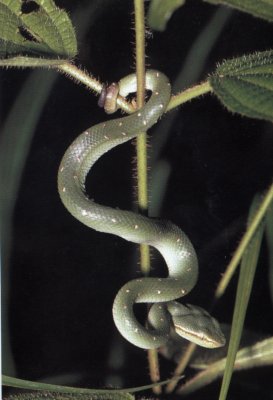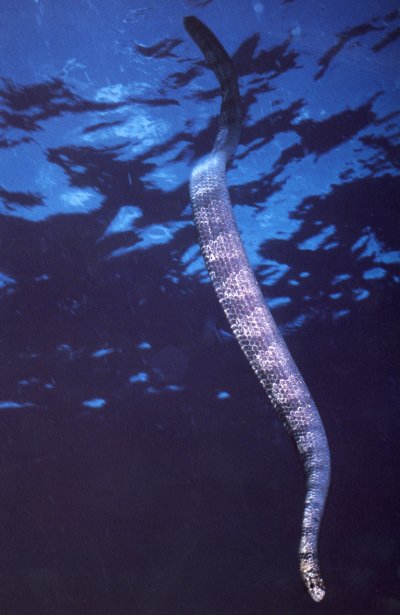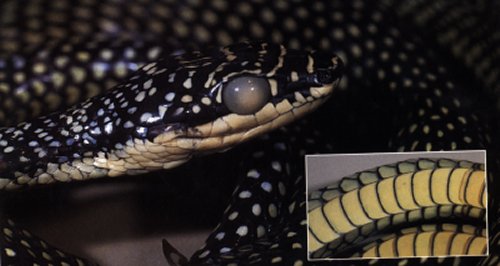

How, though, do snakes perform this amazing feat? By using some fairly simple strategies along with some specialized muscles and long bodies.
To start off there are four different types of movement and each one will be discussed below, but first let's just think about what it takes to move. Well movement itself is simply a part of a creature's body propelling itself through it's environment usually by pushing off the environment itself. Feet push against the ground, tails push bodies through the water and wings push bodies through the air. So what about snakes? Well they push too. Snakes employ the same strategies that all other animals do to move. They push off of their environment, but instead of limbs they use their bellies tails and even their headsThis method of movement is accomplished by the snake lashing it's body back and forth causing lateral waves that force longitudinal motion. To put it another way: They go forward by moving sideways.
Doesn't make a whole lot of sense does it?So imagine a person jumping in diagonal leaps. By the person pushing diagonally off the ground he/she makes a forward movement.
This is the same basic idea with snakes. The head pushes off an uneven portion of the ground and each succeeding bodypart follows where the head left off. What one gets is many waves coming off the snake as each part of the body follows the direction of the head.Now this is not always the case. Some snakes such as Cobras are able to move with a good third of their body held off the ground, so the head doesn't have to start the movement. Plus since many environments contain highly variable pivot points on them the snake must compensate on the fly. This requires very good neuromuscular control or "mind-belly coordination" as it were.
To see the HUP in action one would say that it looks more like the snake is flowing over it's environment much like water. Indeed the lashing is next to impossible to notice, but if one were to place a snake HUP'ing onto a smooth surface like glass or one where the ground is very weak to lateral movement like sand then the lashing becomes quite evident as the snake starts throwing itself off to the side.Another popular name for this is the "inchworm" mode. Although the movement is basically the same, no snake makes such a huge vertical loop as that of an inchworm. No infact seeing the snake raise any part of it's body off the ground is usually quite hard to notice.
In RP the snake raises a portion of it's belly scales forward causing the ends of the scales to poke out like daggers. The snake then stabs these parts into the ground and pushes the belly scales straight which moves the snake forward. But it's not as straightforward as that, for as one set of belly scales pushes forward another set is already positioned for stabbing and pushing. This process is commonly called "rib-walking" but the ribs themselves play no part in it. This is all strictly muscular and the forward movement is made possible both by strength of the muscles and integrity of the scales.Rectilinear progression is painfully slow and is used by the large boids mostly because their bodies won't allow for the contortionary requirements of HUP. Another useful thing about RP is that it allows the snake to move forward in a straight line which allows the snake to stay hidden. This mode is also seen in snakes stalking their prey or just calmly moving along. Much like HUP, Rectilinear progression is also very fluid looking in design and makes the snake look almost as if it's sliding through it's environment.


Sidewinding is the snake running across the sand.
In sidewinding only two portions of the snake are on the ground at one time. Much like the concertina progression both the head and tail are used, but now a third portion of the body is employed. The middle. With the snake firmly anchored with both head and tail, it thrusts it's mid-portion forward, as the mid-body lands the head is telescoped forward. When that lands the tail starts coming up. As the tail comes up the mid-portion again is thrust forward, then head, then tail and so forth. This movement creates vertical pressure on the ground much like that of a foot pushing down. This allows the snake to move forward with out slip sliding away and unlike concertina progression, sidewinding keeps it's momentum and then some.The tracks themselves look like a series of short separated straight lines set at a 300 angle from the direction of progression. The ends of the tracks consist of a J on one side (where the head and neck were) and a T on the other side (tail). For those wishing to know which direction the snake was going just follow the hook of the J, but realize that the T will be more in line with the destination.
All the mid-sized snakes are capable of sidewinding and many will do a crude version of it if pressed, but only the truly desert species ala Crotalus cerastes, Candoia aspera, Cerberus rynchops and some more rather short bodies snakes are truly proficient at it. Sidewinding has allowed these animals to conquer their desert habitats.

The horizontal undulatory progression lends itself well to moving through water and is employed by most aquatic serpents. Even large snakes like Python reticulatus and Eunectes murinus are known to use HUP in the water (something large boids generally avoid doing on land).
When swimming most snakes keep their heads above water and move their bodies from the neck down to push their way through the water.Now this is for most snakes, but the truly amphibious types have gone even further. Dorsally placed nostrils, a longer lung, a more laterally compressed body and an efficient osmoregulatory system, all are hallmarks of the marine snake.
Of the 55 known species of true marine snakes all are elapids. Elapids are fixed fanged snakes with predominantly neurotoxic venom and include such famous snakes as corals and cobras. The possible reason for this is that a more neurotoxic venom will have a quicker effect on an animal like a fish that could otherwise make a speedy getaway and holding onto prey could be too detrimental to the snake.The bodies of these ophidians range from cylindrical (the more archaic variety have this) to almost 2D lateral compression. In the latter their marine existence means that they would have as much luck as a pilot whale if they got beached.


Well sorta
Flight as a term in itself means to travel through the air. This can be broken up into flapping flight (ala birds and insects) gliding flight (Draco lizards, Sugar Gliders) and Parachuting flight (Flying frogs, Flying geckos). The last one is where flying snakes go. These snakes have longitudinal hinges on their ventral scales which allows them to create a concavity which creates more surface area for air to pass through which creates drag, which slows descent and voila, we have flight.
This is only used by certain snakes (Genus Chrysopelea) and seems to be used more for escape then anything else (although transport to neighboring trees would also employ this).
When preparing to fly, many flying snakes will assume the concertina mode with their tails firmly anchored to a tree limb. They will then thrust themselves out and let go of the limb flinging them out into space where they flatten their bodies and parachute down a couple dozen feet to a nearby platform.